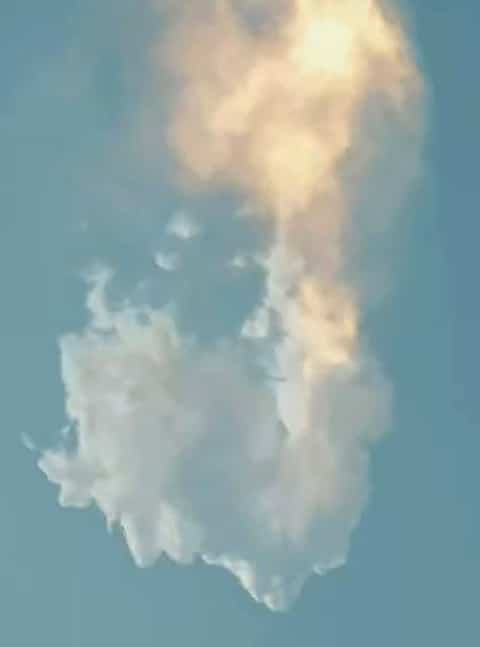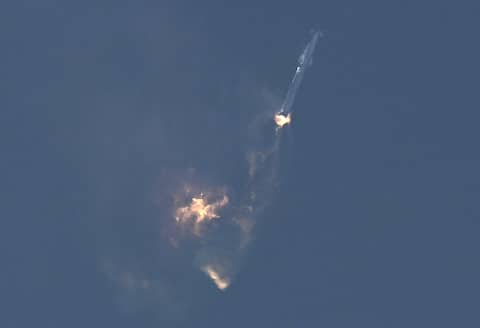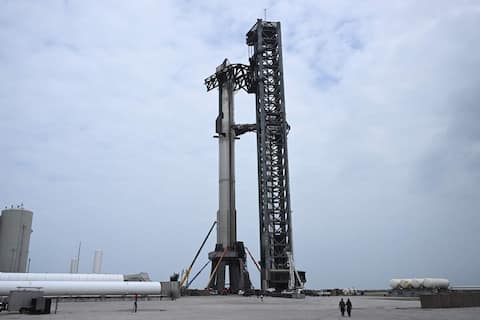The world’s largest rocket, Starship, developed by SpaceX for trips to the Moon and Mars, exploded in midair shortly after liftoff, but this first test flight is already a huge success for the company .
• Read also: A large part of Elon Musk’s fortune rests on SpaceX
In a gigantic ball of fire, this 120-meter-tall black and silver behemoth tore itself from the ground around 8:30 a.m. local time, to the shouts of joy from SpaceX employees.
The scene of this highly anticipated spectacle was SpaceX’s Starbase space base, located in southernmost Texas, United States.
The cause of the explosion is not yet known. The purpose of this test flight was to collect as much data as possible to improve the following prototypes.
On Monday, a first launch attempt was canceled in the last minutes of the countdown, due to a technical problem.
- Listen to the interview with Olivier Hernandez, director of the Montreal Planetarium on the Mario Dumont show via QUB-radio :
“This is the first flight of a huge, very complex rocket,” SpaceX boss Elon Musk said on Sunday, calling the test “very risky.”
At 120 meters, Starship is both larger than NASA’s new mega-rocket, SLS (98 m), which took off for the first time in November, and the legendary Saturn V, the rocket of the Apollo lunar program (111 m).
Starship’s liftoff thrust is also about twice as powerful as these two launchers – making it the strongest in the world.
It had never flown before in its complete configuration, with its super-powerful first stage, called Super Heavy and equipped with no less than 33 engines.
Only the second stage of the vehicle, the Starship spacecraft which by extension gives its name to the entire rocket, had carried out suborbital tests (at an altitude of around 10 km).
It was he who was chosen by NASA to become, in a modified version, the lander of the Artemis 3 mission, which must bring astronauts back to the lunar surface for the first time in more than half a century. officially in 2025.
- Listen to the chronicle of Loïc Tassé, specialist in international politics at the microphone of Benoit Dutrizac on QUB-radio :
On Thursday, the flight plan was as follows: About three minutes after takeoff, Super Heavy was to break away and fall back into the waters of the Gulf of Mexico. But this separation did not take place, the rocket continuing to rotate before exploding.
If the separation had been successful, the Starship would then have to fire up its six engines and continue its ascent on its own, up to an altitude of more than 150 km. After having made a little less than a turn of the Earth for about an hour, it was to fall back into the Pacific Ocean.
But getting through all these steps on the first test flight would have been a real feat.
Elon Musk had wanted to temper expectations, saying that reaching orbit on the first try was unlikely.
He had contented himself with hoping that the launch pad hadn’t been destroyed by the explosion of Super Heavy’s engines at ignition.
“My biggest wish is that, please (…) we are far from the launch pad before something goes wrong,” he said.
The rocket already has customers: Starship’s first crewed flight is to be made with American billionaire Jared Isaacman.
Japanese billionaire Yusaku Maezawa, and American Dennis Tito (the first space tourist in history), have also said they want to embark on a trip around the Moon.
Starship must be able to carry up to 150 tons of cargo into orbit. For comparison, SpaceX’s Falcon 9 rocket can only carry a little more than 22 tons in low Earth orbit.
But the real innovation of Starship is that it must be fully reusable – something Elon Musk thinks achievable within “two or three years”.
For this first test, it should not be attempted to recover any of the two stages of the rocket. But eventually, Super Heavy will have to come back and rest against its launch tower, equipped with two arms to immobilize it.
The Starship spacecraft will have to return to Earth using retrorockets. It was this maneuver that had been attempted several times in 2020 and 2021. After several explosions upon landing, a prototype had finally successfully landed.
The idea of a reusable launcher, Elon Musk’s grand strategy, is to cut prices. Each Starship flight could ultimately cost only “a few million” dollars, he claims.
An imperative for the billionaire, who estimates that humans will need hundreds of Starship rockets to have a chance of becoming a multiplanetary species. Its ultimate goal is the establishment of an autonomous colony on Mars.
![[À VOIR] SpaceX's Starship rocket explodes mid-flight](https://nvts-gb-ldn-actualnewsmagazine.actualnewsmagazine.com/english/wp-content/uploads/2023/04/A-VOIR-SpaceXs-Starship-rocket-explodes-mid-flight.jpg)



